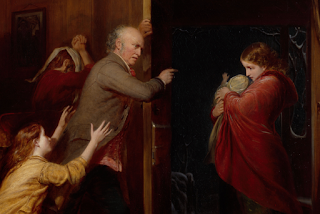Agnes Martin retrospective @ Tate Modern, 2015 - Introduction to a response
What’s the effect of curating a show by an artist of such rarefied means? Does it simplify the exercise, because painting is all she’s got (the odd sculptural object besides)? Does it raise new challenges, because, formally speaking, most of her canvases are all of a type (the early biomorphic abstractions and pre-grid works besides)? How do you engage a broad and varied audience within such parameters, and with an artist who was so (a) abstract (‘there’s nothing to see’), (b) minimalist (‘did she do anything different?’), and (c) expressive (an absence of narrative is cause for anxiety, I might argue, in today’s rationally inclined climate, so sceptical of articulations of sensibility and emotional response).
These are some of the questions that come to mind as I sit to write my first blog piece on the Agnes Martin retrospective, which I visited perhaps ten times or more over the course of this summer. I was ineluctably and automatically affected by the works on display—and perhaps therefore by the show—afforded such peace of mind and room for thought that the inspirational value was beyond value. I wanted to see the pieces again and again, to feel again and again some of what I felt quite by accident and completely by surprise during my first tour; to learn and to experience; to understand on some level (but which I didn’t know) what these paintings could and did do for the viewer. They offered a chance to calm the chattering mind, to demand that the intellect didn't demand anything of what was before its eyes, to demand that I looked and felt and thought but didn’t articulate. And the first fruits of this effort were born during my second visit in the room filled with pencil grids—Room 5 of the naturalistic titles, among them Tree, The Rose and Grass—where, when I sat to give The Rose some time, vision was overtaken by a shimmering shifting of rectangles small and large, foldings and eruptions that signified nothing of a rose to me (new meditations are never easy) but which delighted me in a similar way to how I had been taken quite involuntarily by A Grey Stone during my first visit, a canvas which rewarded both cursory glances and contemplative inspection.
To have been affected like this made me curious, and so I embarked on a programme of research combining personal analysis in the gallery alongside reviewing certain supporting and critical media. Martin’s recent biography by Nancy Princenthal, Dia Art Foundation’s collection of essays on the artist, and eventually the documentary Agnes Martin: With My Back to the World, which I watched with an audience that contained the filmmaker, Mary Lance, who then participated in a question-and-answer session, satisfied many questions and opening new avenues of inquiry. Formal study and recording personal reactions like this led me to a number of interim conclusions that I wish I had had the opportunity to formalise before now, but perhaps the distance of time and the effort of remembering will make my analysis—which I wish to be disciplined about, and focus on the curation—more nuanced and a richer reflection on what I feel about the show, and how to curate an artist of such rarefied means, so abstract, so minimalist, so expressive.
These are some of the questions that come to mind as I sit to write my first blog piece on the Agnes Martin retrospective, which I visited perhaps ten times or more over the course of this summer. I was ineluctably and automatically affected by the works on display—and perhaps therefore by the show—afforded such peace of mind and room for thought that the inspirational value was beyond value. I wanted to see the pieces again and again, to feel again and again some of what I felt quite by accident and completely by surprise during my first tour; to learn and to experience; to understand on some level (but which I didn’t know) what these paintings could and did do for the viewer. They offered a chance to calm the chattering mind, to demand that the intellect didn't demand anything of what was before its eyes, to demand that I looked and felt and thought but didn’t articulate. And the first fruits of this effort were born during my second visit in the room filled with pencil grids—Room 5 of the naturalistic titles, among them Tree, The Rose and Grass—where, when I sat to give The Rose some time, vision was overtaken by a shimmering shifting of rectangles small and large, foldings and eruptions that signified nothing of a rose to me (new meditations are never easy) but which delighted me in a similar way to how I had been taken quite involuntarily by A Grey Stone during my first visit, a canvas which rewarded both cursory glances and contemplative inspection.
To have been affected like this made me curious, and so I embarked on a programme of research combining personal analysis in the gallery alongside reviewing certain supporting and critical media. Martin’s recent biography by Nancy Princenthal, Dia Art Foundation’s collection of essays on the artist, and eventually the documentary Agnes Martin: With My Back to the World, which I watched with an audience that contained the filmmaker, Mary Lance, who then participated in a question-and-answer session, satisfied many questions and opening new avenues of inquiry. Formal study and recording personal reactions like this led me to a number of interim conclusions that I wish I had had the opportunity to formalise before now, but perhaps the distance of time and the effort of remembering will make my analysis—which I wish to be disciplined about, and focus on the curation—more nuanced and a richer reflection on what I feel about the show, and how to curate an artist of such rarefied means, so abstract, so minimalist, so expressive.

Comments
Post a Comment